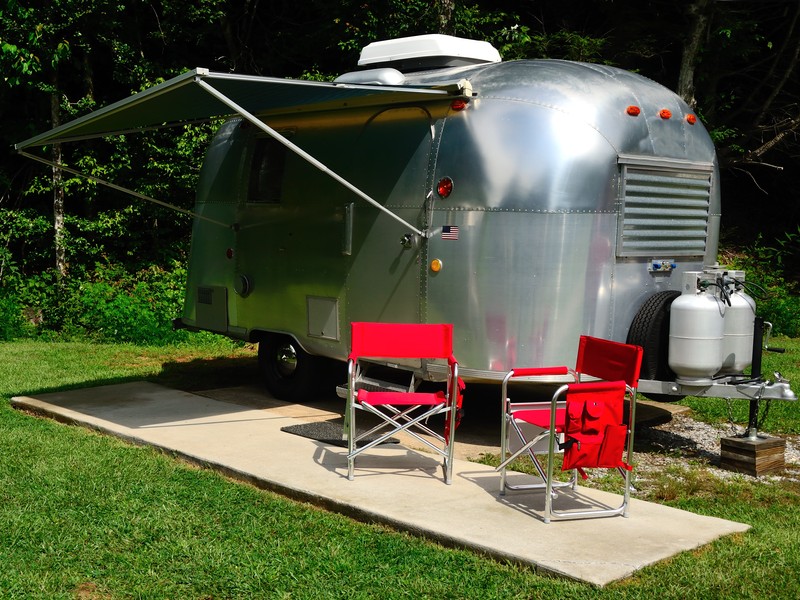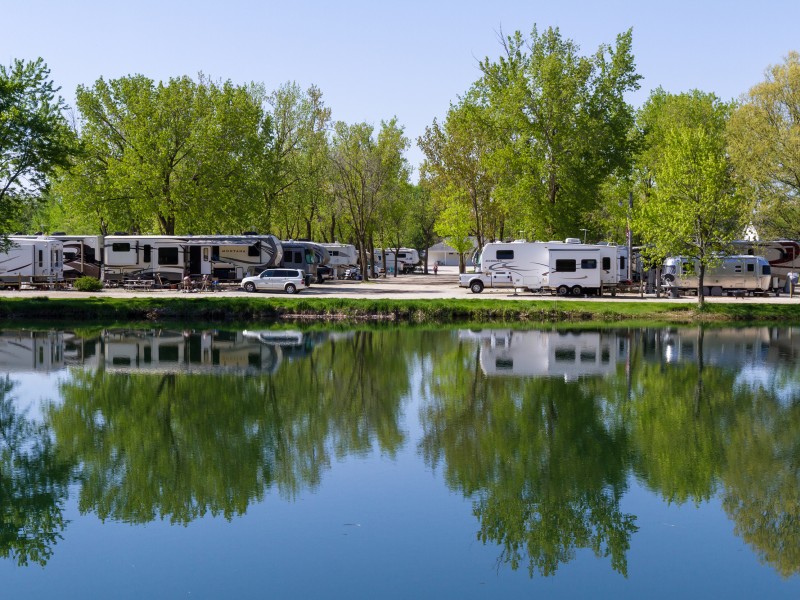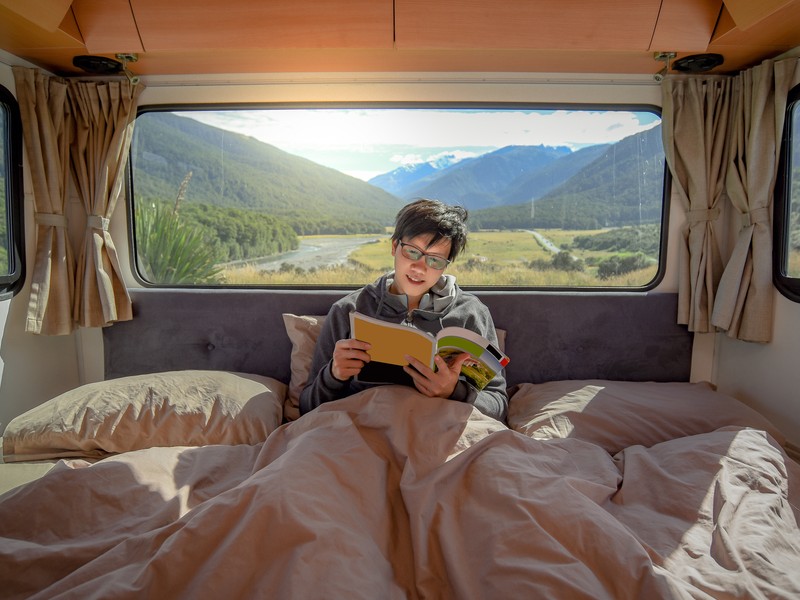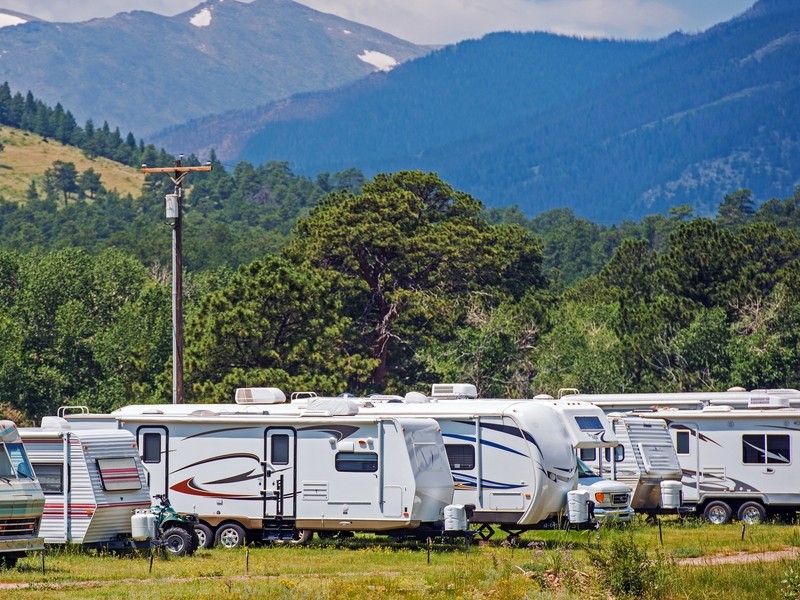Camping outlets today offer a vast collection of gadgets and gizmos that are specially designed for a wide variety of outdoor activities.
When you’re first gearing up for camping trips, it’s tempting to stockpile gear and downsize. For any and every imaginable situation, you never know what you’ll encounter when you’re outside of your comfort zone in the backcountry.
Especially for beginners, it can seem like grabbing all of the store’s offerings is the best way to stay safe and comfortable.
But after a while, all this gear can really add up, cluttering your campsite and contributing little to your enjoyment of the outdoors.
If you always have to make several trips back to your car, or if you find yourself wheeling your gear to your campsite on a dolly or in a wheelbarrow, that’s a good sign you may have more than you really need.
Even if you haven’t gotten to that point yet, it may still be worth reflecting on the virtues of downsizing the equipment you bring with you when you go camping. After all, if you want to be maximally comfortable and surrounded by the amenities of modern life, then why leave home at all?
A core reason why many people head to the campground in the first place is to get away from the trappings of civilization. And so it’s a bit ironic that today we often find ourselves bringing as much civilizing gear as we can carry when we head outdoors.
This article explores why it may be a good idea to consider downsizing your gear and offers tips for effectively trimming down what you bring with you.
Why Downsize When Camping?
The most significant step to take when attempting to lighten your load is reevaluating your attitudes toward your outdoor experiences. Here are some reasons to rethink what you want from your experience and what role your gear should play in your adventure.
Once you’ve shifted your perspective a little bit, downsizing becomes much easier.
Closer Connection with Nature
One of the major benefits that come with a downsized campsite is getting more in touch with nature during your camping excursions. It’s like camping on the beach. A campsite that is filled with equipment makes campers feel more at home, but it also transforms the place from a wild area to a domesticated one.
If, on the other hand, you adopt a minimalist approach and bring only what you really need, you’ll feel more truly like you are in a place that’s out of the ordinary for you.
This may help your outdoor experience become a little more thrilling and perhaps help you get a little closer to the original purpose of going camping in the first place.
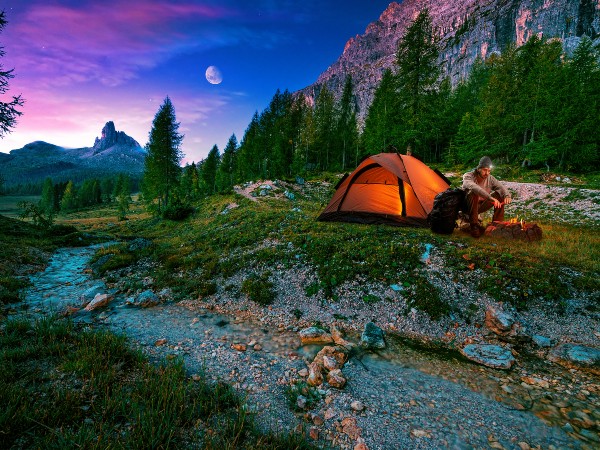
In addition to a sense of unfamiliarity, having less gear means fewer distractions, which in turn means more of your attention can be devoted to noticing the little things around you—the little caterpillar crawling on your boot, the tree bark gnawed by a beaver, the sound of the water from the nearby stream or the spectacular light show offered nightly by the stars.
These are the reasons you come to the outdoors, after all, and with less gear to set up and play with, you have more time to take in the sights and sounds and relish your time outdoors.
More Opportunities
Cutting down on your gear can open up more outdoor opportunities for you. Many breathtaking campsites require significant hikes, and you simply cannot take advantage of them if you need a wheelbarrow to bring all your gear with you.
For example, some remote campsites in the deep woods or up on mountaintops cannot be accessed with carts, and the hike into these places will be too much to do multiple times just to set up camp for a night or two.
You’ll also be able to engage in “thru-hiking,” where you hike to camp one day, then pack up and hike to another camp the next night, and so on, until you finish the trail.
This can be a great way of seeing a wider diversity of what’s out there, offers a great outdoor challenge, and leaves you with some great stories and memories. But it’s not feasible to go on this adventure if you bring too much stuff.
Tips for Downsizing While Camping
When planning changes to the set of gear you bring camping with you, there is no need to rush and figure it all out at once. It’s best to make thoughtful changes that will work over the long term rather than make dramatic shifts that aren’t sustainable and will detract from your precious time away from home.
Try shifting a few things around each time you go and pay attention to what works and what doesn’t. Over time, you will wind up with a streamlined kit that meets all of your needs but doesn’t go overboard.
Take Notes While Camping
A really great way to hone your gear is to take notes while you’re out in the field. You will be more acutely aware of what is needed and what is collecting dust while you are out there actually using your gear.
It can be a little more difficult to remember the exact thoughts you had when you return home, so it’s a good idea to take field notes by bringing a pen and notepad or just taking notes on a phone app.
When you’re planning for your next camping trip, go back and consult your field notes and trust the wisdom of your previous self on what to leave behind.
When Was the Last Time You Used It?
Everyone’s camping styles and preferences are different, so there isn’t a definitive list of what you must bring and what you can leave behind. But you can get great personalized advice by always asking about when the last time you used a piece of gear.
If it has been a while, you’ll want to do a checkup first and see if there are any RV problems to worry about.
If you’ve been lugging a fancy gadget to camp but haven’t used it in the last two or three trips, that’s a good sign you don’t need it. Go through each piece of gear and keep track of how much use it gets.
If you haven’t been using it, then you probably won’t use it soon, and it’s a good candidate for the closet.
How Versatile Is It?
The most useful gear can serve multiple functions or be easily adapted to different circumstances (e.g., colder and warmer weather).
As a general rule of thumb, very specialized gear only can be used in very specialized circumstances. Unless you ensure those circumstances arise regularly, you can probably leave it at home. This is also good advice to consider when making purchasing decisions: if it only does one thing or only works in very special situations, look for more versatile options that can do an adequate job across a wide range of circumstances.
Would a Smaller One Work?
Another great way to downsize your gear is to look for smaller, lighter alternatives when you go camping. For example, with the increasing use of gear with rechargeable batteries (e.g., lamps, phones, smartwatches), many people bring backup battery banks with them when they camp.
This is a perfectly good practice, but it’s possible to go overboard.
If you’re carrying a five-pound power bank for a two-person weekend trip, you’re adding a lot of weight and space to your kit that goes unused, and a much smaller battery would give you all you need plus a little extra as a safety margin.
Go on a Backpacking Trip
One of the best ways to get a sense of what is really needed and what isn’t is to go on a backpacking trip. While backpacking, you will be taking everything you bring to the outdoors with you on your back.
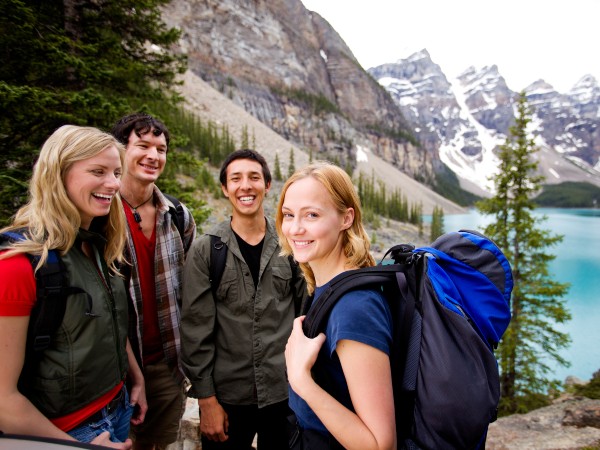
The space constraints of the pack already put a check on how much you can bring. But the fact that you will be carrying all of the weight at once also provides a very strong incentive to leave all unnecessary gear behind.
You’ll think twice about bringing all the extra bells and whistles when you can feel their weight with each step you take.
Read Up on Ultralight Backpacking
A common practice among dedicated ultra-lighters is posting complete lists of all the gear they plan to bring on their trip online and then soliciting criticism from fellow enthusiasts.
The basic question is: “Do I really need this?” And the community can easily identify unnecessary dead weight. You don’t necessarily need to post your gear list and subject yourself to public criticism online.
But if you habitually read these “gear shakedowns,” you’ll begin to get a sense of what ultra-lighters deem unnecessary, and it will help give you some perspective when you evaluate your own gear options.
Gain Experience
A final general tip for camping and downsizing is to just go out there and gain more experience. Practice new techniques and read up on expert advice.
Often, a little more knowledge can directly translate into fewer needs on the trail.
For example, if you get better with a knife, you may be able to get by with a more versatile multi-tool knife and not need to also bring a huge butcher knife in addition to the multi-tool you’re already bringing.
Gear Recommendations: The Necessities
Just because you want to trim down your load doesn’t mean you should head out empty-handed, and here are a few of the things all campers should think about bringing to the woods:
Shelter/Tent
The most essential piece of equipment is a solid shelter to protect from the elements and wildlife. You want to make sure you will get some coverage from rain and bugs and be comfortable in the space you stay in.
That said, you don’t need a palace. A tent needs to be a place you can sleep comfortably, not a place to host a big party.
You don’t need to stand up inside or even have enough space to store all of your gear. Many tents come with vestibules that cover some space outside the main tent body, so you can even stash your daytime gear outside while keeping it dry.
That opens up the possibility of getting a small, lightweight tent that fits a few sleepers and maybe a few small pieces of gear like a headlamp, phone, and book. Minimalists just go for attaching a hammock or tarp to the trees and maybe slipping into some bug netting.
Pack
You do need a device to pack and carry your gear with you. If you are camping with a car nearby, one or two duffle bags might do the trick. This makes downsizing a lot easier when you go camping.
But it might also be worth looking into a larger backpack designed for outdoor activities. Backpacks can also be used to ferry gear from the car, but they also open up the possibility of more long-distance adventures down the road.
Sleeping Bag
Another essential is a sleeping bag: You want to ensure that you stay warm and comfy at night. Make sure the bag fits your body well so that you don’t have more material than you need.
A bag rated between 20 F-30 F will be versatile in spring, summer, and fall conditions.
Sleeping Pad
Sleeping pads might seem like a good candidate to leave behind in your downsizing efforts when camping, but even many minimalist campers like to bring one with them.
You can find compressible pads that can be easily inflated or even closed-cell foam pads that are lightweight and offer some decent support.
Just because you’re downsizing doesn’t mean you need to suffer through uncomfortable, sleepless nights, and the added insulation and padding offered by sleeping pads make them a solid piece of basic equipment.
Explore the Great Outdoors with Us!
Appropriate Clothing
Obviously, you will need clothing! But the emphasis here is on appropriateness.
You don’t need to have complete changes of clothes for every day and night you’re outside. After all, you aren’t going to fancy restaurants or shows.
It’s okay to get a little smelly while camping, so long as you shower upon returning home. Consider having one dedicated set of sleeping clothes and maybe one—or at most two—sets of daytime wear.
(Exception: bring an extra pair of socks and underwear for daytime wear). Read the weather carefully before going so that you don’t show up with jackets, gloves, and winter hats that you won’t ever need.
Basic Cookware
Everyone needs to eat, but we don’t need an entire kitchen to accomplish that. One of the main places where people get more than they need is in the cookware department.
You don’t need several stoves, multiple grilling implements, and whole sets of utensils. For many purposes, a very simple stove that attaches to a fuel canister can be used for boiling or simmering water in a pot and frying things in a small pan.
A single spork can work just fine, getting the food into your mouth and cutting down on the clutter and the amount of cleaning needed. Plan out food choices that work well with a minimalist kitchen setup.
Other Essentials
Here Are a Few Other Key Pieces of Gear That Are Important to Bring:
- Toiletries
- Simple Multitool
- Sun and Bug Protection
- Light Source
- Fire Starters
Gear Recommendations: What to Leave Behind
There’s a lot of gear on the market that goes far beyond what is needed for a safe and fun camping experience. Here are some of the items that most tempt campers to go overboard.
Consider leaving them behind if you have them or avoiding them if you are currently considering them.
Bulky or Specialized Cooking Equipment
A lot of recent innovation has come to camp-kitchen offerings. Modern stores now offer huge grills that are fit to feed a football team and special gear to make single items like grilled cheese or freshly scrambled eggs.
This equipment isn’t necessary. With a little practice, you can make lots of great food with a simple stove that holds a pot and a pan.
If you’re camping with a family or a larger group, it may be worth getting a slightly bigger pot or pan. But in most cases, it’s worth challenging yourself to see how much you can do with a simpler kitchen setup.
Portable Shower Systems
Another type of product that isn’t needed is a portable shower system. While it can seem like a nice idea to take a shower while camping, these shower systems tend to be bulky and cumbersome to use.
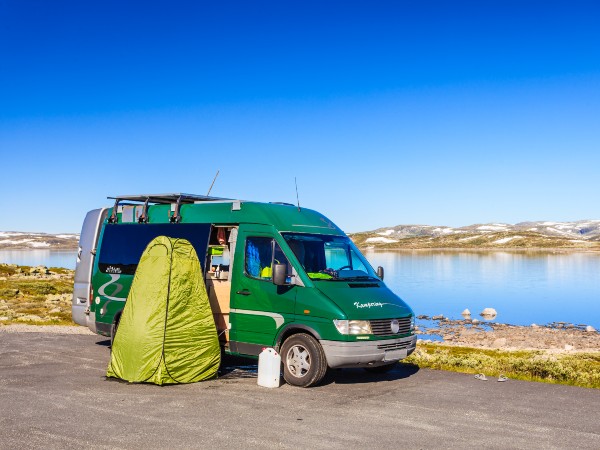
If you bring some good biodegradable camp soap, you can easily wash down with a few drops of soap and two water bottles—one to lather up with, the other to rinse off with. The water bottle technique isn’t very difficult and doesn’t require any extra gear.
Axes/Saws/Machetes
A very common but unnecessary category of gear for downsizing when camping is equipment for cutting firewood. If you’re breaking down a tree in your backyard, then maybe these things have a role to play. But when you’re camping, they aren’t needed.
First, you don’t want to be setting up roaring bonfires. Best practices call for relatively smaller fires that can fully consume all of the wood you prepare for the night.
A typical rule of thumb is not to seek thicker wood than an adult’s wrist. Branches of that thickness can be broken down simply by holding up one end and stomping in the middle of the branch.
Most places will have plenty of firewood if you look around for a bit, and many campsites even sell locally cut wood, completely eliminating the need to hack up large logs.
Speakers
Many companies are making speakers that are marketed for outdoor use in the woods. These can be left behind in almost all circumstances.
First, other people around the campsite went there to get some peace and quiet away from society. Blaring music or audiobooks on your speakers isn’t very considerate of those around you.
If you really want to listen to something at a respectful volume, the speakers built into your phone should be able to do the job without disturbing the other campers.
Only if you have a very large group and no one is nearby might it be appropriate to consider bringing speakers to the campground with you.
Conclusion
Downsizing one’s camp gear is primarily about changing one’s attitude about the goals of the camping experience.
Once you embrace the outdoor aspect of the adventure and start looking for ways to minimize the things you bring, you start to find all sorts of unnecessary gear that can be trimmed down or left behind completely.
You don’t need to let go of all the extra gear at once. But making thoughtful changes over time can really transform your time outdoors. Good luck as you work to streamline your kit!
Remember, downsizing is simple as long as you have the right camping priorities. It’s not as difficult as it sounds. Truly, from my experience, downsizing your camp gear is actually fun and memorable!
How to Minimize Your Stuff (Video)
Related Questions
- What are some specific examples of gear that can be downsized or eliminated for a more minimalist camping experience?
For a minimalist camping experience, you can downsize or eliminate certain gear such as a tent by opting for a lightweight hammock or bivy sack instead.
Additionally, rather than carrying a full cook set, you could bring a simple stove and a single pot for cooking, and replace traditional camping chairs with a lightweight, packable option or simply use logs or rocks at the campsite.
- How can one balance the need for safety and preparedness with the desire to downsize camping gear?
One can balance the need for safety and preparedness with the desire to downsize camping gear by investing in multi-purpose, lightweight equipment that doesn’t compromise on essential functions.
It’s also crucial to plan meticulously, considering the specific needs of the trip, such as weather conditions and terrain, and packing only the necessary items that ensure safety and survival.
- Can you provide some examples of multi-purpose gear that can replace several single-purpose items?
Sure, a Swiss Army Knife is a classic example of multi-purpose gear, combining tools like a knife, screwdriver, can opener, and scissors into one compact device.
Another example is a smartphone, which can replace a camera, GPS, calculator, music player, and many other single-purpose items.
- How can one evaluate whether a piece of gear is truly necessary for their specific camping style or trip?
To evaluate the necessity of a gear item for your camping style or trip, consider its relevance to the core activities and challenges you’ll encounter.
Assess if it enhances safety, comfort, or efficiency while being mindful of weight and space limitations.
- What are some strategies for gradually downsizing camping gear without feeling unprepared or uncomfortable during trips?
Start by identifying gear that serves multiple purposes or can be replaced with lighter, more compact versions, and invest in high-quality, multifunctional equipment to reduce the overall volume.
Make incremental changes, testing out your pared-down setup during shorter trips before longer ones, allowing you to adjust comfortably while ensuring you’re prepared for different situations.
"Of all the paths you take in life, make sure a few of them are dirt."
-- John Muir

